Renovations to begin on clinic elevators
Beginning this month the clinic elevators will be renovated, leaving
only two clinic elevators in operation during clinic hours.
The renovation comes as part of the upgrades leading to the opening of
the Mark O. Hatfield Clinical Research Center. According to Don Sebastian,
CRC project coordinator, the three clinic elevators will be refurbished
to run faster and in coordination with the two new Clinical Research Center
elevators that are located directly across from the current clinic elevators.
"During the renovation at least two of the current elevators will
always be in operation," said Sebastian. "There could be a slight
slow down for patients who use those elevators, but otherwise, it shouldn't
be a serious inconvenience."
If for some reason one of the two operational elevators go out of service,
then one of the new CRC elevators will be used. A CRC construction employee
will operate the new elevator until the out of service elevator is operational.
The current clinic elevators may shut down due to mechanical or computer
problems. According to James Wilson, CRC project coordinator, general
wear and tear has been the main reason the elevators shut down. "Dust
and dirt can cause the elevators to go out of service, but like most machinery
once it gets older, parts wear out and begin to deteriorate."
Signs will be posted on the out-of-service elevator and in the clinic
lobbies to make patients and staff aware of the renovations. Patients
will be directed to use the main elevators and the staff elevators to
access the clinics. New signage will be made available near the main elevators
to assist with directing patients to the clinic.
The renovations will take up to 36 weeks to complete and will include
new ceiling tiles in the clinic lobbies, new push buttons and keycard
accessible doors leading from the clinic elevators to the lab areas.
Signs will be posted on the out-of-service elevator and in the clinic
lobbies to make patients and staff aware of the renovations. In addition,
the signage will be improved in Building 10 by the main elevators so that
patients and staff can also use the main elevators and staff elevators
to access the clinics.
Back
to Top
Blossoming into a princess
|
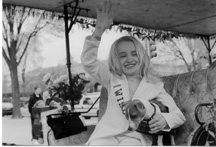
For more than 20 years, Brianne Schwantes has been treated at the
Clinical Center for Osteogenesis Imperfecta or brittle bone disease.
Last month, this 23-year-old college senior represented her home state
of Wisconsin as a Cherry Blossom Parade Princess.
|
When Brianne Schwantes was born 13 bones in her body were broken. Doctors
in her hometown of Milwaukee, Wisc. told her parents to place her little
body on a pillow and forget about her because there was nothing that they
could do for a child born with Osteogenesis Imperfecta or brittle bone
disease.
That was 23 years ago. Today, this Clinical Center patient, who has been
adopted into the families of Clinical Center physicians and researchers,
donned a crown and sash as she toured the Capitol, took pictures with
First Lady Laura Bush and received gifts from the Japanese Embassy as
one of this year's Cherry Blossom Parade princesses.
"Every girl's dream is to become a princess and wear a crown and
sash," said Brianne, a senior at American University majoring in
Communications Law and Economics and Government. "When I was born
I don't think my parents ever thought that I would be riding on a carriage
down Constitution Avenue as a princess."
Brianne has undergone more than 50 surgeries and plenty of broken bones
in her lifetime, yet she maintains an upbeat attitude and spends her free
time volunteering and helping other people.
"I'll never be cured, but I'm doing really, really well,"
said Brianne. "My dad says I'm like a classic car. When I'm running,
I run really well, but when I crash I need the best mechanics to fix me."
Lately, she's been running without any problems. So much so, that when
she applied to be a Cherry Blossom Princess, she also convinced three
of her college friends to do the same. Although, "it wasn't too hard
to convince them to be princesses," she said.
The 10-block parade down Constitution Avenue last month wrapped up a
week's worth of activities for each of the 53 ladies who represented their
respective state, plus three international participants representing Thailand,
The Netherlands and Lithouania.
|
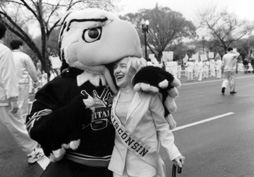
Washington
Capitals mascot, Slapshot, playfully bites the head of Brianne as
she prepares to take her carriage ride down Constitution Ave.
|
For one week Brianne woke up at 7 a.m. to travel around D.C., attend
congressional luncheons, participate in a tree planting ceremony and visit
the Hungarian and Japanese Embassies, where she received received gifts,
and visited children at the Kennedy Institute where she and fellow constituents
crowned the little girls. The night before the parade the ladies dressed
in white evening gowns and were escorted to the princess ball by gentlemen
from the Naval Academy.
"It was a magical week. It was just wonderful to be treated like
royalty," said Brianne. "We had a chance to see the academic
side of Washington and be a guest of the government. It is an experience
I will never forget."
Despite the drizzle of rain and cold weather, the parade went on. While
the other princesses walked in their business suits and high-heeled shoes,
Brianne was escorted in a carriage along with the Goodwill Ambassadors,
who serve as cultural liaisons and promote goodwill and friendship between
the United States and Japan.
Her sorority sisters, college friends, family and Clinical Center family
cheered her on as she passed by.
"Brianne is an athlete in a body that presents maximal challenges,"
said Dr. Lynn Gerber, chief, Rehabilitation Medicine Department. Dr. Gerber
has been treating Brianne since she was a baby. "Ever since infancy,
she has had drive, determination and a can-do attitude. We are all so
very proud of her."
Brianne has spent much of her life helping others. As a child she raised
$20,000 for South African orphans and went to Iowa and Georgia to help
flood victims. She is also a motivational speaker and travels to schools
and community organizations across the country. She has been recognized
by former President Bill Clinton during one of his speeches and has also
been on the Oprah Winfrey Show.
Although her bones could have easily broken while filling sandbags for
flood victims or missing a step while stepping off of an airplane, Brianne
takes it all in stride.
"I've had to deal with a broken pelvis and leg within the past
year," she said. "You just go with it and get used to having
to use a walker for awhile. This is me against the disease."
Brianne will receive the Outstanding Service University Community Award
from American University in May. It is the third highest honor given to
students who are highly involved in community activities.
–by Tanya Brown
Back
to Top
State-of-the-art elevators will reduce wait time
in CRC
When the Mark O. Hatfield Clinical Research Center opens next year, patients
and staff will be able to move throughout the building much faster because
of the 32 state-of-the-art elevators designed to reduce wait time through
faster operation.
"Elevators are very important to NIH," said Leon Pheder, CRC
project manager. "If we are going to err, then we will err on the
conservative side instead of being short changed."
Based on a survey conducted to determine the number of elevators needed
to efficiently move people throughout the CRC, staff and patients will
have less than a minute to wait before boarding and unboarding an elevator.
"For staff elevators the wait time will not exceed 30 seconds. For
elevators designated for patients and visitors, the wait time will not
exceed 45 seconds," said Pheder. "People will immediately be
able to see a difference.Ó
The new elevators will be computer-driven and positioned to sit on different
floors at different times. ÒIf there are five elevators grouped together
and one is sitting on the first floor, then the other four wonÕt be on
the first floor,Ó said Pheder. "But as soon as that first floor elevator
goes up, then one of the other four elevators will immediately move back
down to cover the first floor."
According to Pheder, the elevators will be programmed to sit on the lower
floors in the morning, when patients and employees are generally going
up. By the evening rush home, the elevators will be sitting on the upper
floors to bring patients and employees down more quickly.
Although each of the 32 elevators have not yet been designated for staff
or patient use, there are four specialized elevators for varying departments.
The elevator next to the OR will run between the second and third floors
to help transport patients from the OR to the ICU. A dedicated elevator
in the Nuclear Medicine Department will be for animal transport only between
the first floor and B3 level. A similar elevator will transport animals
from the B3 loading dock area to the B2 level. The last specialized elevator
will be used by staff who walk from Buildings 1 and 31 into the CRC. To
avoid having them walk to the front of the CRC, they can walk to the side
of the building and an elevator will take them to the B1 level.
Two additional clinic elevators will join the three current clinic elevators.
The current clinic elevators are being renovated to operate as efficiently
as the new elevators. Once the CRC opens, these five elevators will be
designated for staff use. Directly behind the clinic elevators will be
four more elevators designed to handle all patient and visitor traffic.
Four elevators will be placed at the front entrance of the CRC and used
for Code Blue, patients, visitors and staff. Additional elevators in the
patient wings will also be used for Code Blue, patients, visitors and
staff. Two service elevators will be located at the end of each lab wing.
The elevators will be designed with wood grain panel and ceilings, and
tile floors. Designated service elevators will have a stainless steel-designed
panel with tile floors and wood grain ceiling.
Back
to Top
LaRoche retires after 40 years of service
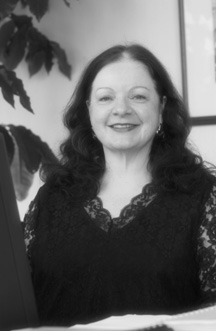
Sue LaRoche
|
After a 40-year federal career, Susan LaRoche will retire
this month from her position as Hospitality Services Coordinator.
"Over the past 40 years I have watched NIH grow,"
said Sue. ÒWhen I first came to NIH in 1963 there were no metro trains,
no shuttle busses, no computers, faxes, or copiers. The NIH police were
called guards and weren't authorized to carry weapons, and President Carter
made us pay for parking for a short while."
Sue began her career in 1963 as a clerk in the Nutrition
Department. She later moved up to secretary to the chief in the Nutrition
Department. She worked there for 19 years until coming to the Office of
the Director where she served as staff assistant. She was responsible
for phone coverage, scheduling meetings, timekeeping, and travel. Sue's
clear commitment to excellence was recognized with an award for her outstanding
performance and initiative.
In 1970, Sue enrolled in the NIH Upward Mobility College
or UMC and received a Bachelor of Arts degree in English. UMC was a program
that allowed employees to pursue a college degree, free of charge, with
an excused absence from work.
That degree allowed Sue to move into the Special Events
Department of the Clinical Center as a Public Affairs Specialist where
she was responsible for giving tours of the Clinical Center to foreign
visitors such as the Ambassador of Rwanda.
Sue served for three years on the NIH Women's Advisory
Committee, an inter-institute committee sponsored by the Equal Employment
Opportunity office. While Sue was Chairperson of this committee, Secretary
Donna Shalala was invited to attend one of the committee's meetings. This
meeting turned into an NIH extravaganza and was broadcast on CNN.
In December 1999 the Clinical Center Hospitality Services
program was developed to guide visitors to their destinations and assist
them with special needs. Sue became a member of the Hospitality Services
staff and subsequently accepted the position of Hospitality Services Coordinator.
Sue returned to the Director of the Clinical Center in 2002
to represent the hospitality aspect of the Clinical Center in the Director's
Office. She assisted with projects such as preparation of the Clinical
Center Customer Service Program notebooks and the 2003 Strategic and Annual
Operating Plans.
"Sue has always done an outstanding job by assuring
that everyone feels welcome. We will miss the vibrant personality she
brings everyday to work," said Clinical Center Director Dr. John
Gallin.
"She had just the right personality for the role.
She interacted well with all staff and consequently was well liked. Departmental
staff enjoyed coming into the office because Sue was always willing to
listen and to assist them with whatever they needed," said Alberta
Bourn, chief, Nutrition Department.
Sue said she plans to enjoy retirement, but will not overlook
an opportunity to come back to the place where she gave so much of herself.
"This summer I plan to relax, work in my garden, enjoy my new hot
tub, read, and give lots of tender-loving care to my husband and six cats,"
said Sue. But don't be surprised if you see me back again in some capacity.
I think I will miss the Clinical Center too much to stay away for good."
–by Erin Dominick
Back
to Top
Clinical Center online
In an effort to share the Clinical Center's online information a new
feature begins this month in Clinical Center News. Clinical Center Online
will appear on a regular basis to highlight technical applications, web
topics and informatics issues.
Web Content Management
A new content management tool, Collage, is being pilot tested by the
Department of Networks and Applications and the Office of Communications.
Collage enables end users to better manage content of their sites. Three
Clinical Center websites are included in the pilot project: Nursing Internet
Site (http://www.cc.nih.gov/nursing/index.html);
Laboratory Medicine Intranet Site (http://intranet.cc.nih.gov/dlm/); and Strategic Planning Intranet Site (http://intranet.cc.nih.gov/
od/pod/strategicplan02/). If successful, the pilot phase will be extended
to other sites and end user groups. The Collage software is provided by
Merant. For more information on Collage visit www.merant.com
or contact Dianne Needham, dneedham@cc.nih.gov.
New Websites
As the Clinical Center's Internet (external) and Intranet (internal)
web presence progresses new and revised sites are in development. The
Department of Laboratory Medicine has a new intranet site that provides
information on their Master Test Guide, Specimen Guidelines and Transport,
Test Reports, and more. For more information visit http://intranet.cc.nih.gov/dlm/ or contact Alba Murphy, amurphy@cc.nih.gov.
The Office of the Director has a new intranet site that provides details
of the Clinical Center's Emergency Management Plan. Each employee should
be familiar with this emergency preparedness content. For more information
visit http://intranet.cc.nih.gov/od/
emergencyplan/ or contact Laura Lee, llee@cc.nih.gov.
ProtoType
ProtoType is a web-based protocol writing application that will assist
researchers in the development and approval of protocols. Version 1.0
will undergo testing this summer.ProtoType is being developed by the Office
of Protocol Services. For more information contact Kim Jarema, kjarema@cc.nih.gov.
Readers are invited to share news items and ideas for Clinical Center
Online. Email dneedham@cc.nih.gov.
–by Dianne Needham
Back
to Top
Team NIH
The Susan G. Komen Breast Cancer Foundation
Race for the Cure
Registration for Team NIH continues. For those who haven't registered
there is still time to do so either at local malls, coffee shops, stores
and schools throughout the area.
The in-person registration fee is $25; the online fee is $30 before May
17 and $35 from May 17-30. There will also be onsite race day registration
on June 7. Don't forget to indicate the code "NIH" when registering.
Race packet distribution (for those who registered at Building 10) will
be 11am-2pm, June 4-5 outside the second floor cafeteria in the Clinical
Center.
On the actual race day morning Team NIH will gather at 8am at the corner
of 15th and Constitution Avenue (look for the large pink NIH signs). For
more information on Team NIH contact one of the team coordinators: Pat
Piringer, ppiringer@cc.nih.gov, 402-2435;
Georgie Cusack, gcusack@cc.nih.gov, 594-8128;
or Dianne Needham, dneedham@cc.nih.gov,
594-5788. Visit www.nationalraceforcure.org
for more details and background on the National Race.
Back
to Top
Fire protection a way of life for a dedicated team
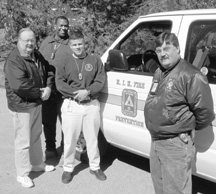
Assistant Fire Marshals (l-r): Dan Walther,
Michael Garner, John Frecker, and Paul Davis.
|
Except for the emergency vehicle parked out front, NIH visitors could
easily confuse the two-story brick house, known simply as 15G-2, as just
another residence. In fact, if they were to enter, they might be tempted
to ring the doorbell, despite the sign by the garage reading "Fire
Prevention."
In a way, it's very much like a home to the NIH assistant fire marshals
who work there. They're frequently leaving to perform a host of duties
ranging from intensive and frequent training courses for the Clinical
Center's nursing, maintenance and household staffs to public education
events, to working with engineers in ensuring that current and future
workspaces are fire-safe and certified."
"Once it gets in your blood, it's there to stay," said Assistant
Fire Marshal Dan Walther, whose father was a firefighter in Prince George's
County, Md. Since he was eight years old, he's been around firehouses
and, like every other assistant fire marshal, manages to fit in volunteer
service in addition to his weekly activities.
"When you're a kid, you always want to be a firefighter,"
he said. "You see the red trucks going out with the sirens and lights
and it's exciting." But that only got his attention. At 12 he began
getting interested in the real part of the job–helping people.
"When you see what a fire can do to people, and how other people
can help, you say to yourself, 'Hey, maybe I could do some good.'"
Walther today is a volunteer for the Prince George's County Fire Department.
Besides firefighting, he learned the electrical trade from his father–skills
he still relies upon heavily when working with fire alarm systems.
Coming to NIH in 1975 as an electrician, he transferred to the NIH Fire
Department for 11 years, then switched from fire fighting to fire prevention.
"The fire service has changed," he said. "Now the emphasis
is on public education."
Assistant Fire Marshal Paul Davis agrees. A firefighter with 28 years
of experience behind him, he points to the volumes of fire codes in his
office, much of which is being constantly revised by federal, state and
local agencies.
"The fire protection business is equally as tough of a job as fighting
fires," he said. Davis not only inspects the Clinical Center complex,
but the Rocky Mountain Lab in Montana (30-35 buildings), the Gerontology
Research Center in Baltimore, Md. and the NIH Poolesville Farm, Poolesville,
Md. (30-35 buildings).
Fire suppression, or firefighting to Davis, who literally grew up in
the fire service, also is a family tradition. His great grandfather, grandfather
and uncle were all firefighters, and Davis' oldest son is a volunteer
and career firefighter-making it a fifth-generation tradition that may
well continue. "It's something that comes from within, "and
many will say it's in the blood," he said. "There's a lot of
self-satisfaction that comes from helping people."
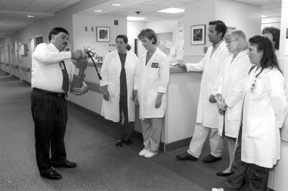
For assistant fire marshals, one aspect
of the job is proper training. Davis trains Clinical Center staff
about fire safety and prevention.
|
Like the other assistant fire marshals, Davis pulls one night per week
of shift duty with the NIH Fire Department, working a full 24-hour period
in a 56-hour workweek. Yet he still finds time to work as a volunteer
with the Walkersville Volunteer Fire Company, where he was a past assistant
fire chief, and the Walkersville Volunteer Rescue Company, both in Frederick
County, Md., where he is a past Chief. He began his career as a volunteer
firefighter in his early twenties as a volunteer at the Gaithersburg Washington
Grove Fire Department, Gaithersburg, Md., and in 1979 began his federal
firefighter career at the Walter Reed Medical Center Fire Department,
Washington, D.C.
Bringing a military background to the team is Assistant Fire Marshal
Michael Garner, a retired Marine with almost 20 years of aircraft and
onboard firefighting and fire protection inspection experience.
"I was used to fires on aircraft," he said. "The larger
planes are just like houses because of their size." Inspecting them
and investigating crashes were similar to the type of work he does now
with house and office fires, but also "different." Garner also
served shipboard, where malfunctioning arresting gear on planes forced
them to make tight landings. "During the forward carrier landings,
we had to have all the trucks out and every position manned," he
explained. Working in close quarters at sea or on the ground required
a special form of teamwork, a teamwork that drives him in his job.
"I'm a people person," he said. "In fact, my favorite
part of the job is the people. You have to be oriented that way if you're
going to project what you know. You have to get their interest. The key
is to keep it simple and not try to make it too technical. I think of
myself as fun and I like to bring out laughter in people. It makes it
that much more enjoyable."
The fourth member of the team is Assistant Fire Marshal John Frecker,
who's been with NIH for two years. His great grandfather was a career
firefighter in Pittsfield, Mass. His grandfather was a fire chief in Washington,
D.C., and his father a lieutenant in the D.C. Fire Department. "I've
always been around it," he said, though he vacillated between firefighting
and law enforcement. During the early nineties, he spent three summers
as a police officer in Ocean City, Md., while he was a student at the
University of Maryland. From there he signed on to the Montgomery County
Fire Department in 1993, where he not only served as a firefighter, but
as a hazardous materials technician and specialist with a focus on weapons
of mass destruction. In 2001 he joined the office of the NIH Fire Marshal.
"I've always wanted to do what I'm doing now," he said. "And,
in a roundabout way, what I'm doing is being what I was, a volunteer firefighter
and law enforcement officer–there are elements of both in a fire
marshal's office."
Frecker, like so many of his fellow assistant fire marshals, enjoys working
with people. His specialty is fire investigations, fire code enforcement,
specialized training and conducting Clinical Center fire drills and mock
evacuations. As a volunteer with the Kensington Volunteer Fire Department,
Kensington, Md., he's become an acting district (battalion) chief with
a rank of captain. As a volunteer, he has taken part in the aftermath
of many major fires and incidents in the county, including a 1996 train
wreck in Silver Spring and a subsequent train derailment in 2002 in Kensington.
"It's something I enjoy doing. I've always been around it, ever
since I can remember being around anything."
–by John Iler
Back
to Top
Springtime on the windows of 9-West
RaeLynne Sanders (left photo) along with Cheyenne Hunter and Samantha
Edgar (right photo), brought Spring to 9-West by painting butterflies,
flowers and other spring-like figures on each window on the floor. The
project, initiated by Art Therapist Esther Epstein and coordinated by
Recreational Therapist Vera Sales, was designed to help kids express themselves
through art as well as offer something fun to take their minds off of
being in a hospital.
Back
to Top
May
calendar
|
|
7
Grand
Rounds
noon-1 p.m.
Lipsett Amphitheater
Should Surrogates Be Informed of PatientsÕ
HIV Test Results?
Rebecca Dresser, J.D., Washington University, St. Louis, MO
Wednesday
Afternoon Lecture
3 p.m.
Masur Auditorium
Fascinating Strategies Used by the Bacterial Pathogen Listeria Monocytogenes
to Establish an Infection Pascale Cossart, Ph.D., Pasteur Institute
Knight of the Legion or Honor
14
Grand
Rounds
noon-1 p.m.
Lipsett Amphitheater
Heartache and Heartbreak: Important Interactions of Depression
and Cardiovascular Disease
Charles Nemeroff, M.D., Ph.D., Emory University
Wednesday
Afternoon Lecture
3 p.m.
Masur Auditorium
What Makes it Tick? Attempts to Understand the Dynamics of the Ribosome
Using Cryo-Electron Microscopy Joachim Frank, Ph.D., New York
University, NY
|
21
CRIS
Grand Rounds
noon-1 p.m.
Masur Auditorium
Treatment of Refractory Cancer Pain with Intrathecal Drugs: Implications
for Sustained Pain Control, Relief of Drug Side Effects, and Possibly
Improved Survival
Thomas Smith, M.D., Virginia Commonwealth University
Molecular Neurosurgery for Treating Severe, Refractory Pain
Andrew Mannes, M.D., CC and NIDCR
Wednesday Afternoon Lecture
3 p.m.
Masur Auditorium
From Long-Term Gradients to Local Cell Shape Changes: How the Drosophila
Embryo Controls its Morphogenesis
Eric F. Wieschaus, Ph.D., Princeton University
|
28
Grand Rounds
noon-1 p.m.
Masur Auditorium
The Clinical Spectrum Caused by Defects in Initiation of Protein
Translation Raphael Schiffmann, M.D., NINDS A Dynamic Picture of
the Tumor Microenvironment Francesco Marincola, M.D., CC
Wednesday
Afternoon Lecture
3 p.m.
Masur Auditorium
Tracking Immunity In Vivo
Richard M. Locksley, M.D., University of California
|
Back
to Top
Editor:
Tanya C. Brown
Contributing
writers: Dianne Needham, John Iler, Erin Dominick
|
|
Clinical Center News, 6100 Executive Blvd., Suite 3C01, MSC 7511,
National Institutes of Health, Bethesda, MD 20892-7511. Tel: 301-496-2563.
Fax: 301-402-2984. Published monthly for CC employees by the Office
of Clinical Center Communications, Colleen Henrichsen, chief. News,
article ideas, calendar events, letters, and photographs are welcome.
Deadline for submissions is the second Monday of each month
.
Back
to Top
|
|

